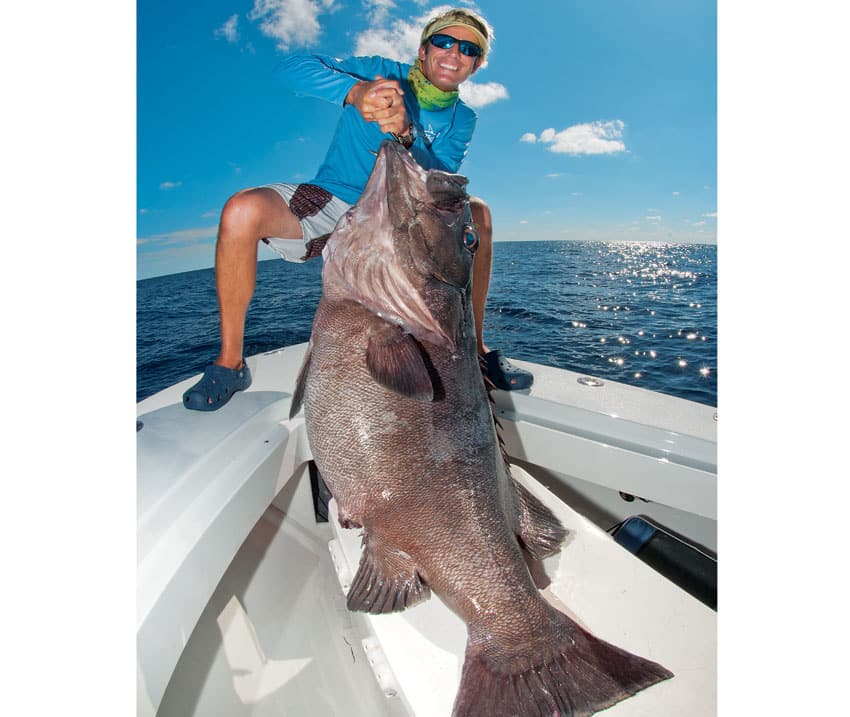
Fishing in water 600 feet and deeper isn’t the same as dropping bait over the side on a shallow reef in search of common snapper or grouper. Fishing shallow is a relatively easy task, but when you’re seeking fish that live in total darkness and frigid temperatures a quarter-mile or more beneath the surface, you need to be prepared.
Most people who fish in very deep water use deep drop electric reels. Some readers may object to that, and if you’re one of them, you can always opt to fish deep water manually, but that’s quite a chore. Just reeling up a line to change a bait can take 25 minutes or more, depending on the depth you’re fishing. Winding add-on tools can alleviate the pain of cranking in a deep drop fishing reel.
No matter what, definitely research the type of deep drop fishing reel you will feel most comfortable with. Brands like Kristal, Shimano and Daiwa produce electric and power assist reels, and some manufacturers such as Hooker Electric modify traditional Penn and Shimano reels with motors. Then, there are companies like The Reel Crankie that produce a tool you can connect to your reel and wind line with a power drill.
Deed Drop Electric Reels
Dick Julylia ranks as an acknowledged expert at fishing in these great depths. When I first met him many years ago, he worked as a representative for Cannon, a maker of downriggers, and had mastered subsurface trolling for wahoo. He later got into deep-dropping and has been perfecting the techniques he now uses with such skill ever since. He currently works as an advisor to Kristal Fishing, a manufacturer of high-quality electric fishing reels. We caught up with Julylia recently to get some deep-drop fishing techniques for those of you who might like to give it a try.
“Electric reel manufacturers have developed products to help catch everything from sailfish to swordfish,” Julylia said. “In the past, deep drop electric reels were heavy and cumbersome, and some required special electric converters. Today, the best electric reels for deep drop fishing can operate on a single 12-volt battery and have come down in size. Electric reels have added a new frontier to catching fish in waters as deep as 2,000 feet.”
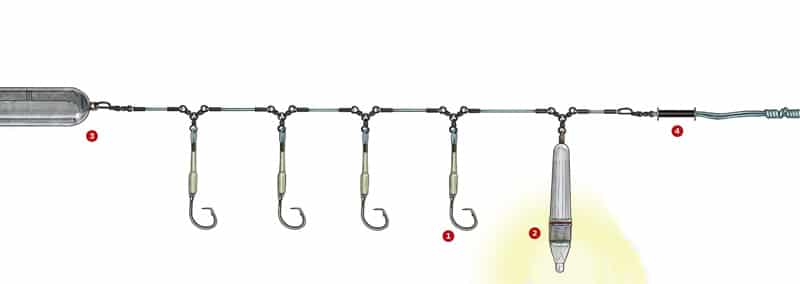
Deepwater Rig
Deep Drop Fishing Rigs
Julylia has perfected the tackle needed to winch big fish from very deep water, and as you might expect, this is not a light-tackle game. “I use a Kristal 651 reel because of its pulling power and line capacity,” he said. “It’s attached to a 6-foot bent-butt heavy-duty rod with a swivel tip and roller guides. For line, I use 200-pound-test no-stretch braided Spectra-based line.”
Julylia ties a Bimini twist into the braid as a shock absorber. “The double line helps prevent any loss of rigs or damage when the line comes up to the rod tip, which can happen since the reel is very powerful,” Julylia said. “I will make a 15-foot leader of double line and slide on a number-one stainless-steel washer, then a one-inch piece of outboard-motor gas hose, then another washer and finally a 300-pound-test Sampo ball-bearing swivel. With this setup, I’ve covered all my bases and can use my electric reel for deep-dropping, for pulling teasers while trolling or with a Z-Wing for deep-trolling tuna or grouper.”
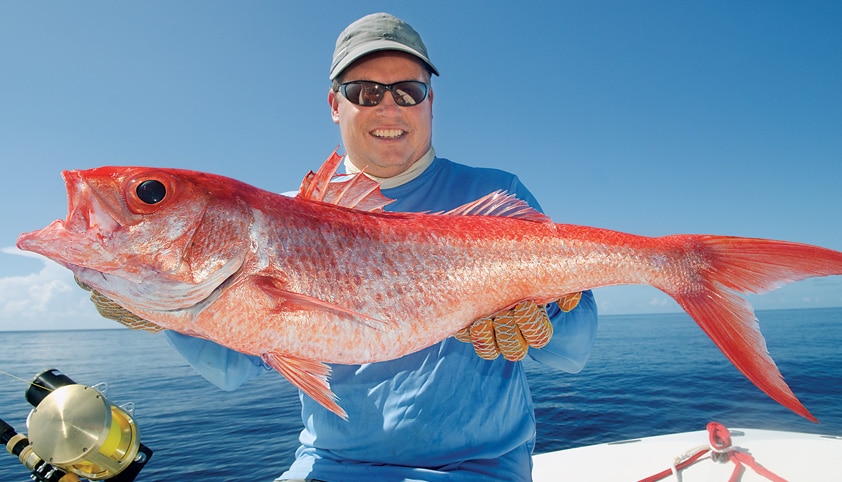
Deep Drop Terminal Tackle
Deep-dropping is merely bottom fishing at great depths, so the fish you’re likely to encounter will live near the bottom. All good deep-drop fishing rigs are made with circle hooks and nylon monofilament main line and leaders. Julylia recommended specific hook sizes for general use. “Use 9/0 circle hooks for fish under 10 pounds, 13/0 or 14/0 for most other fish and 16/0 hooks for large grouper,” he said. “Remember, the circle hook needs to get around the jawbone of larger fish.”
Deep Drop Fishing Lights
“As the water gets deeper, the light diminishes; any light source near your hooks will attract more bites,” Julylia said. “There are many deep drop fishing lights available, in all colors — some even make noise — and they’re priced from quite inexpensive to $150 each. Chemical lights like Cyalume sticks are another source, used by commercial fisherman for years. The only issue I have with Cyalumes is that they are not deepwater friendly and can be used only once.”
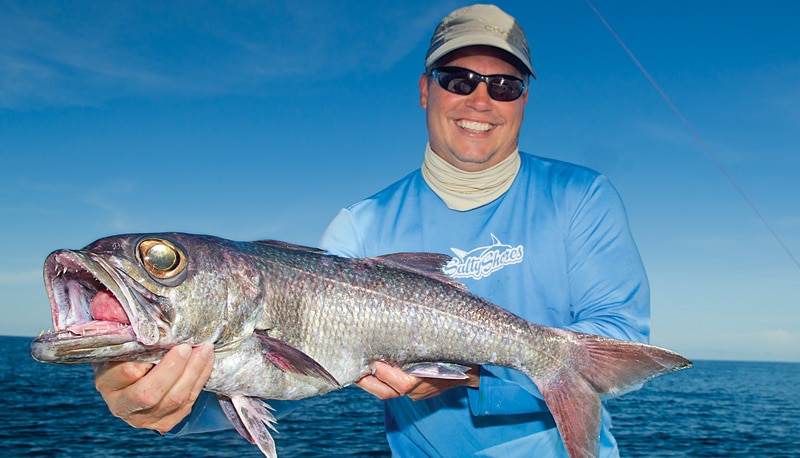
Top Baits for Deep Drop Fishing
One of the most interesting aspects of deep-dropping concerns the species you’re likely to encounter. These bottom dwellers bear little resemblance to the shallow-water species we’re all more familiar with. Instead of mutton and red snapper, plus gag grouper, you’ll be looking for things with unfamiliar names like wenchman snapper, wreckfish, pomfret, scombrops, escolar, silk snapper and tilefish.
Luckily these fish aren’t terribly picky about what they’ll eat, and common baits work well. “Squid is the most effective and most available bait,” Julylia said. “It’s one of the best and can be found in any tackle shop or supermarket. Next to squid, I like fresh barracuda or any other fresh bait. Cut the bait into a matchbook-size piece, and also put a piece of squid on the hook.”
Where to Deep Drop
Julylia said Florida and the Bahamas have been the hotbeds for deep-dropping, but the Gulf of Mexico and the Eastern Seaboard are virgin territories for this fishery. Much of the strategy used in determining what species to target revolves around the depth of water and the specific bottom structure at that depth. “I have reports of huge snapper and grouper being caught in the Gulf, and giant tilefish in the Atlantic,” Julylia said. “Tilefish can be found in 600 feet of water on the bottom, and they prefer muddy areas, where they look for shrimp. Tilefish, once a commercially sought-after fish, have rebounded, and many are caught to 40 pounds all along the Atlantic.
“Snapper and grouper species like hard bottom with some structure,” he continued. “They can be anywhere from 400 to 1,000 feet deep, with wreckfish over 100 pounds in water that’s 2,000 feet deep. Swordfish can be found off the bottom but near it during the day in 1,600 to 1,800 feet of water. Larger hooks and larger baits are needed. At night the swords come closer to the surface.”
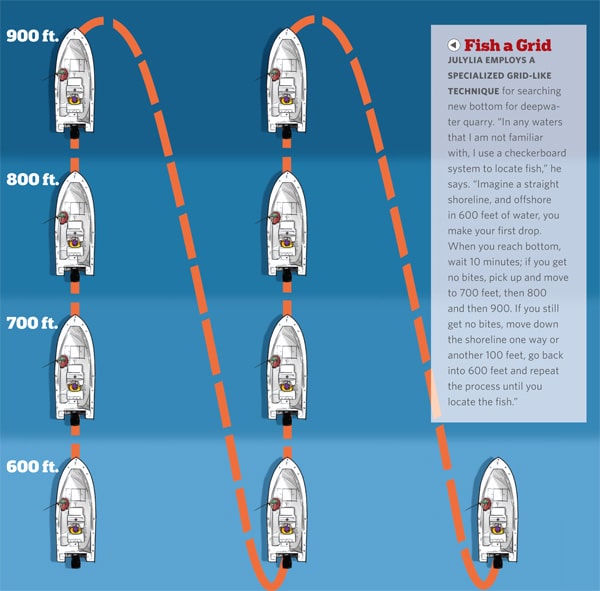
How to Position your Boat for Deep Dropping
Positioning the boat properly before making a drop is critical, and as mentioned earlier, you need to make every drop count. This is not the type of fishing in which you want to be reeling in the rig repeatedly. For instance, much of the tilefishing that takes place off the east coast of Florida is done in Gulf Stream current, requiring a great deal of preparation.
“Fishing in Florida’s Gulf Stream current is a challenge,” Julylia said. “I like to put the bow into the current and vary the idle speed so that the line, as it goes down, is at a slight angle. When you reach bottom, you will be drifting backward, so do not drag bottom. When the current is light, you can just drift and let your rig out. But when fishing heavy current, you sometimes must use as much as 12 pounds of weight in 600 to 700 feet of water when targeting tilefish on a muddy bottom.”
Deep-drop fishing isn’t for everyone, but once you try it, you’ll be amazed by how much fun it is. The best part is when your leader breaks the surface after you’ve hooked a fish, because you will certainly be greeted by an unfamiliar species from far below. That’s part of the charm of deep-dropping, and it’s what keeps guys like Julylia sending baits far below where most of us typically seek fish.
Plan for Deep Drop Fishing
What: Deep-dropping for bottomfish in depths from 600 to 2,000 feet. Species include swordfish, wenchman snapper, pomfret, scombrops, silk snapper, queen snapper, escolar, tilefish, wreckfish and others. Please note that possession of wreckfish by recreational anglers is illegal in federal and state waters off North Carolina, South Carolina and Georgia and along the east coast of Florida. In the South Atlantic Exclusive Economic Zone (federal waters), the wreckfish is a 100 percent commercial individual transferable quota fishery; it is also illegal to land a wreckfish caught recreationally in the South Atlantic EEZ, in states where federal waters are open to recreational wreckfishing, from the North Carolina/Virginia border northward.
When: Year-round.
Where: In Atlantic waters from New Jersey south to Florida; in the Bahamas; throughout the Caribbean basin; and in the Gulf of Mexico.
Rods: 6-foot heavy-duty bent-butt rods with swivel tips and roller guides built specifically for this style of fishing.
Reels: Heavy-duty conventional or electric reels capable of applying heavy drag and handling 200-pound braided line. With conventional reels, use a Reel Crankie winding accessory coupled with an electric drill for retrieving line between drops.
Lines: Braid up to 200-pound-test.
Leaders: Heavy nylon monofilament with multiple circle hooks tied onto three-way swivels or dropper loops.
Baits: Squid or any fresh cut bait.
Hooks: Heavy-duty circle hooks from 9/0 to 16/0.
Extras: Deep-drop lights. Anything from chemical Cyalume sticks to expensive battery-powered colored flashing lights, which are reusable.









